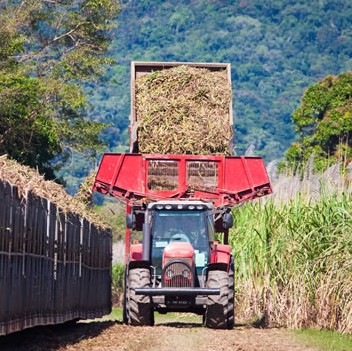Sugar processing: growing, milling, refining
Table sugar comes from sugar cane in Australia and New Zealand
Sugar cane grows from tropical north Queensland down to northern New South Wales
'Raw sugar' from a mill is typically not edible. It must go through a process to make it safe to eat
Table sugar or sucrose is a completely natural ingredient. It plays a vital role in foods and drinks that goes beyond sweetness.
In both Australia and New Zealand table sugar comes from the sugar cane plant. In other parts of the world sugar can come from sugar beet, palm trees or maple trees.
 Sugar cane is a tropical grass which can grow to around 3-4 m tall and is similar to bamboo. To grow well, sugar cane needs warm sunny weather (free from frost), well-drained, fertile soil and lots of water (around 1,500 mm of rainfall a year or access to irrigation). Due to the required growing conditions the majority or sugar cane for harvesting in Australia is grown from tropical North Queensland down to northern New South Wales.
Sugar cane is a tropical grass which can grow to around 3-4 m tall and is similar to bamboo. To grow well, sugar cane needs warm sunny weather (free from frost), well-drained, fertile soil and lots of water (around 1,500 mm of rainfall a year or access to irrigation). Due to the required growing conditions the majority or sugar cane for harvesting in Australia is grown from tropical North Queensland down to northern New South Wales.
Sugar is made in the leaves of the sugar cane plant through the natural process of photosynthesis. Energy from the sun transforms carbon dioxide and water into oxygen and glucose. The excess energy which the plant doesn't need is stored as sugar in the form of a juice found in the plant's fibrous stalks.
Growing sugar
 With adequate rain and sunshine a sugar cane crop typically takes between 16-24 months to mature. New cane is grown from stalks (setts), which are planted in the ground and sprout after two to four weeks.
With adequate rain and sunshine a sugar cane crop typically takes between 16-24 months to mature. New cane is grown from stalks (setts), which are planted in the ground and sprout after two to four weeks.
Once mature, crops are harvested between June to December. A mechanical harvester cuts the cane into 30cm lengths called billets, these are then collected and transported to the mill within 16 hours.
Milling sugar
Once the cane arrives at the mill it is weighed and then shredded. The shredding breaks the fibrous stalks apart, bursting the cells that contain the sweet juice.
Following this, the cane is crushed through a series of rollers, separating the juice from the leftover fibrous material. The leftover material is used to fuel the mill's furnaces. Having extracted the juice, impurities need to be removed. This is done by adding lime and heating. The clear juice is then concentrated by boiling under a vacuum into a syrup.
The syrup is further concentrated and seeded with smaller crystals and spun through a centrifuge to separate the formed crystals and dark syrup. Once dried, these crystals are transferred to storage or transported to a refinery. The sugar at this stage is typically not food grade.
Refining sugar
 The 'raw' sugar from the mill arrives at the refinery where it is mixed with hot syrup to soften the hard molasses coating on the outside of the sugar.
The 'raw' sugar from the mill arrives at the refinery where it is mixed with hot syrup to soften the hard molasses coating on the outside of the sugar.
Once mixed the syrup is put through a centrifuge which removes 50% of the colour from the raw sugar and is then melted into a liquor. The liquor undergoes further clarification via either carbonation or phosphatation and is then passed through activated carbon to remove organic or other residual material.
Next, excess water is removed via evaporation pans and passed through a UV light sterilizer. Finally, the liquid is crystallised, spun through a final centrifuge and dried. It is at the refinery that the many types of sugar products are made.
